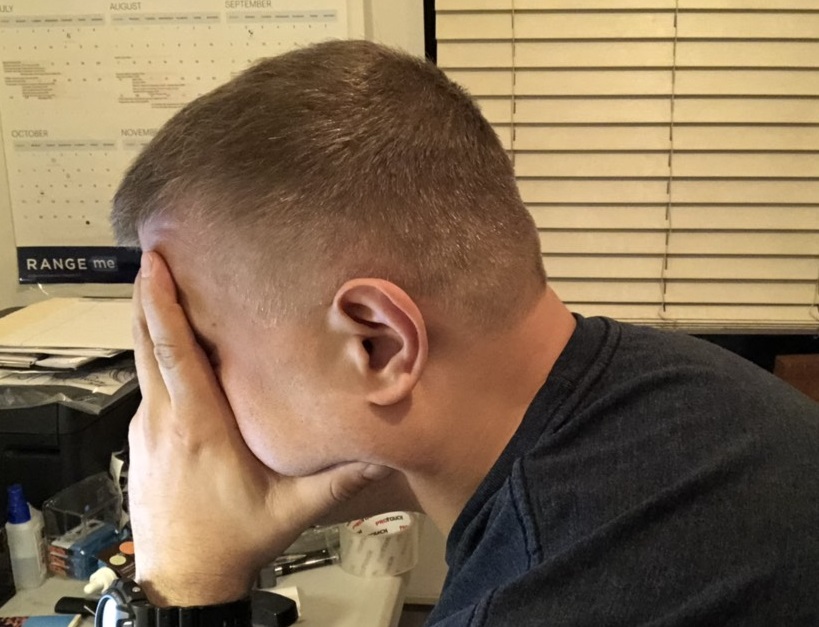Using Routines to Combat Decision Fatigue 3/18/2019
E very morning, I go through the same routine. As soon as I wake up, I open my journal and do a couple of pages of freewriting while having a black coffee. Then, I jump into my workout for the day, whether it’s kettlebells on Mondays, Wednesdays and Fridays or a run on Tuesdays, Thursdays and Saturdays. Then I shower and get dressed for work. Since I work from home, that means one of my pairs of Origin USA joggers, a t-shirt and my Doc Martens sneakers.
very morning, I go through the same routine. As soon as I wake up, I open my journal and do a couple of pages of freewriting while having a black coffee. Then, I jump into my workout for the day, whether it’s kettlebells on Mondays, Wednesdays and Fridays or a run on Tuesdays, Thursdays and Saturdays. Then I shower and get dressed for work. Since I work from home, that means one of my pairs of Origin USA joggers, a t-shirt and my Doc Martens sneakers.
Same routine. Every. Single. Morning.
On a macro-level, my days are broken up into routines, as well. First half of my day – whenever possible – is focused on creative tasks, such as writing, editing, recording videos. Creating content. After lunch, I focus on calls, administrative tasks and other work.
The reason why I do these routines, and why – if you are a buyer or entrepreneur with a million decisions to make each day – you should, too, is to avoid decision-fatigue.
Decision fatigue refers to the steadily deteriorating quality of decisions that occur after a long period of decision-making. Think of your decision-making capability as a battery, and every time you have to make a decision, regardless of whether it’s a big decision or a minor decision, that battery gets depleted a little. The more decisions you make throughout the day, the less juice you have in the battery for future decisions, and we make literally thousands of decisions each day. So if you use up this juice making a lot of minor decisions – such as what you're going to wear for the day, what you're going to eat for breakfast, whether or not to work out -- you're depleting a lot of that battery’s juice and you're going to have less decision-making power left for those important decisions that are crucial to your job or to your life.
Decision fatigue can lead to some serious consequences. In a research study published by the National Academy of Sciences, psychologists examined the factors that impact whether or not a judge approves a criminal for parole, and found that judges tended to give more favorable rulings earlier in the day, and the number of these favorable rulings dropped steadily until just before lunch, when almost none of the criminals received parole. The number of favorable rulings then picked up again after the lunch break, then dropped again toward the end of the day. The same happens with your decisions, whether business or personal. After a long bout of prolonged decision-making, the quality of these decisions drops.
One way to lessen the impact of decision fatigue is by establishing routines, or habits throughout your day in which tasks are executed automatically, without having to use up your decision-making juice in deciding whether or not to do them. You just DO.

In some cases this is easy. Getting your coffee each morning and throwing on some clothes is not particularly taxing; motivating yourself to work out, especially for some people or if we are tired, is. Going back and forth deciding whether or not to go for that run can use up a lot of valuable decision-making energy, energy better spent on more important tasks.
Establishing Routines
Establishing these routines is not easy. In the beginning, you have to consistently force yourself to stick to them until they become a habit. How long does it take to establish such habits? In one frequently-cited study, published in the European Journal of Social Psychology, health psychology researcher Phillippa Lally and her research team concluded that it takes an average of 66 days to establish a new habit. That means 66 days of forcing yourself to regularly undergo a task before it becomes a habit.
How you approach your day can also be broken up into routines, and this is another key component of avoiding decision fatigue. When it comes to the important decisions – those mission-critical ones, the earlier in the day you can make them, the better, as decision fatigue starts to set in as the day progresses and the amount of decisions we make piles up. Because of this, one routine that is critical to adapt is reserving your mornings for your most important or toughest decisions (in many cases, they are one and the same). This is why I try to leave my mornings open for content creation, as that’s the most important component of my job.
But what if you can’t avoid a day of decision-making, such as buyers participating in ECRM programs, who are making hundreds of decisions in meetings throughout the day? One way to add juice to the decision-making battery is to take a quick power nap. A quick 20-minute nap helps to “reset” the mind’s decision-making capabilities and improves mental clarity. However, this is not always convenient. If you can’t squeeze in a power nap, stepping outside or doing some activity where you can let your mind go offline and wander for a bit (they call activating the default mode network) can help restore some of your decision-making capabilities. (Incidentally, at ECRM sessions we do a lot to reduce our participant's decision-making load, such as setting up their appointment schedules, providing all meals, and being on hand for any issues that might come up.)
Additionally, a quick snack, particularly something with glucose (preferably fruit) also helps to get some glucose into the brain to provide more literal decision-making energy, since the brain runs primarily on glucose. You can also do this with snacks or candy, but that can also lead to crashing later on, which will be counter-productive.
So if you want to boost the quality of your decisions – which will not only enhance your productivity but will boost your performance -- get into the routine of getting into routines, focus on those tough decisions earlier in the day – and save the less crucial tasks for later!



